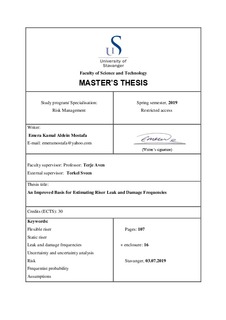| dc.contributor.advisor | Aven, Terje | |
| dc.contributor.advisor | Sveen, Torkel | |
| dc.contributor.author | Mostafa, Emera Kamal Aldein | |
| dc.coverage.spatial | Norway | nb_NO |
| dc.date.accessioned | 2019-11-03T09:25:22Z | |
| dc.date.available | 2019-11-03T09:25:22Z | |
| dc.date.issued | 2019-07-03 | |
| dc.identifier.uri | http://hdl.handle.net/11250/2626227 | |
| dc.description | Master's thesis in Risk management | nb_NO |
| dc.description.abstract | In the petroleum industry, risers are widely used to transport fluids and gases. Risers are intended to be critical integral components as they are subjected to numerous failure factors, where in case of a leak, a highly combustible material may be released. Failure frequency is generally estimated based on historical data, to be used later in the Quantitative Risk Assessment (QRA) in order to reduce the risk associated with leakages. Several works were done previously to estimate the riser failure frequency based on the historical data from the Norwegian Continental Shelf (NCS) combined with other global data sources. The result of previous work relies mainly on assumptions and simplifications where the uncertainties are high, well as poor descriptions and low availability of data and incidents. The main goals of the present thesis are to estimate non-biased leak and damage frequencies for risers and to compare the result with previous studies. Also, in this study, the aim is to define the impact of the result in terms of risks and uncertainty by uncertainty analysis, knowledge characterisation and determining how to use the available relevant information to describe the risk. In addition, the intention is to identify challenges related to data and to provide possible solutions. This study was carried out by studying, systemising, and combining incidents reported to Corrosion and Damage database (CODAM) from Petroleum’s Safety Authority (PSA) and the internal database at Equinor (Synergi). None of the studied databases had a full overview of registered incidents; therefore, different frequencies were estimated from different databases used to highlight the quality of these databases. The quality of the databases used in this study has been enhanced, e.g. multi reported incidents were removed from CODAM with major severity. A combination of the internal registered incidents at Equinor and registered incidents in CODAM was carried out to have a sufficiently large data set. The estimated frequencies for flexible risers from the combined databases are considered to be more robust and less sensitive compared to the estimated frequencies for the static risers. The assumptions which were taken under historical data analysis were highlighted and discussed, and uncertainty analysis of assumptions was done. Besides this, robustness and sensitivity analysis were carried out together with quality classification of the data in order to provide a base for discussion of the results in terms of risk and uncertainty and how to use the historical data to describe the risk. | nb_NO |
| dc.description.sponsorship | Equinor | nb_NO |
| dc.language.iso | eng | nb_NO |
| dc.publisher | University of Stavanger, Norway | nb_NO |
| dc.relation.ispartofseries | Masteroppgave/UIS-TN-ISØP/2019; | |
| dc.rights | Attribution-NonCommercial-NoDerivatives 4.0 Internasjonal | * |
| dc.rights | Attribution-NonCommercial-NoDerivatives 4.0 Internasjonal | * |
| dc.rights.uri | http://creativecommons.org/licenses/by-nc-nd/4.0/deed.no | * |
| dc.subject | flexible riser | nb_NO |
| dc.subject | static riser | nb_NO |
| dc.subject | risikostyring | nb_NO |
| dc.subject | risk management | nb_NO |
| dc.subject | risk | nb_NO |
| dc.subject | leak and damage frequencies | nb_NO |
| dc.subject | uncertainty | nb_NO |
| dc.subject | uncertainty analysis | nb_NO |
| dc.subject | frequentist probability | nb_NO |
| dc.subject | assumptions | nb_NO |
| dc.title | An Improved Basis for Estimating Riser Leak and Damage Frequencies | nb_NO |
| dc.type | Master thesis | nb_NO |
| dc.rights.holder | Equinor and PSA | nb_NO |
| dc.subject.nsi | VDP::Social science: 200 | nb_NO |
| dc.subject.nsi | VDP::Technology: 500 | nb_NO |

